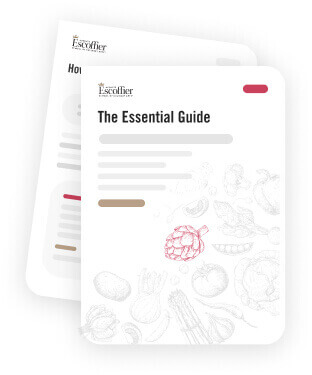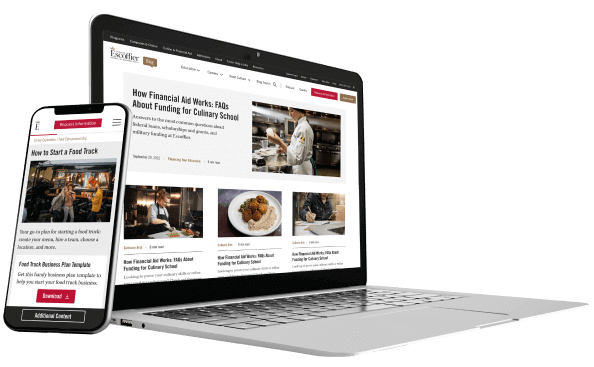Listen to This Article:
When a magazine wants to introduce readers to a new restaurant or a food company has redesigned the packaging for its line of frozen foods, the food itself needs to shine…all without customers tasting or smelling it. That’s where food photographers come in.
While anyone with a smartphone can take a photo of their meal for their personal Instagram account, there’s a lot more to professional food photography than just pointing and shooting! Food photographers must be experts at many skills, including lighting, composition, editing, communication, networking, and even cooking.
If you’re interested in making a career out of capturing the beauty of food, learn more about how to become a food photographer.
What Does a Food Photographer Do?
In the simplest explanation, food photographers take pictures of food. However, there’s more to it than snapping a quick image of their meal. Food photographers take visually appealing images of food to be used in menus, magazines, advertising, cookbooks, and more. Experienced professionals understand the best lighting, angles, and arrangement of the food and accessories to help the dish look as delicious as it tastes. But their work doesn’t stop there.
While food photographers do spend a lot of their time composing and capturing photos, there is more on their agendas than just snapping pics. From finding clients to perfecting their images through editing, food photography requires a combination of creativity, technical skill, and an understanding of business. Let’s dive into more about the process of a food photographer from start to finish.
How do Food Photographers Make Money?
Many food photography jobs are short-term freelance jobs, but you can also find full-time, permanent positions. To look for contract positions, you can head to gig-work platforms like Upwork or Thumbtack. And once you have a strong portfolio, you can even begin pitching your services to magazines and cookbook publishers. You also may want to consider submitting your work to an agency, as photography agents serve as gatekeepers to things like global campaigns for iconic brands.
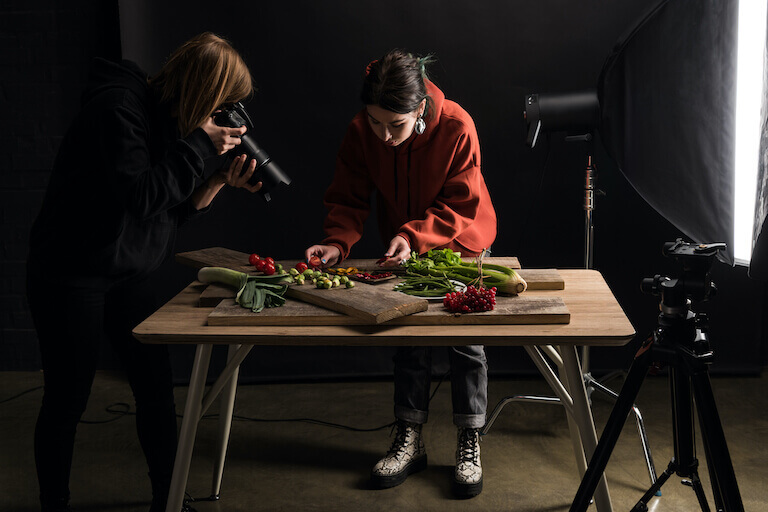
Food photographers may work with stylists and other creatives in executing a high-end shoot.
Remember that pitching can be a numbers game, so don’t be afraid to submit your work to multiple agencies and publications to find one that aligns with your style.
When it comes to looking for full-time positions, the process is similar to looking for other jobs—head to job websites. Of course, you may also be able to hear about positions by networking with other professionals in the food photography and styling industry.
Another option is to upload your photographs on websites such as Shutterstock. Each time someone downloads your image, you will receive a small commission.
So, you know what a food photographer does and how they can make money, but how do you actually get from where you are now to where you want to be in your food photography career?
What’s the Career Path for a Food Photographer?
While there’s no one set path to becoming a food photographer, many people find it helpful to follow a few steps.
Develop an Understanding of Photography
Before you can jump into capturing jaw-dropping photos of food, you’ll need to understand how cameras work! While you can take nice photos with the point-and-shoot cameras found on today’s smartphones, professional food photographers typically work with digital cameras that give them more control.
Many food photographers use digital single-lens reflex (DSLR) or mirrorless cameras. With DSLR cameras, light reflects off of a mirror and into a viewfinder, while with a mirrorless camera, light goes directly to an image sensor. As a general rule of thumb, picture the type of camera in which you can swap out lenses.
In either case, these tools allow for manual manipulation of multiple factors, including shutter speed, aperture (the opening in the lens), and ISO (sensitivity to light). They also typically offer the user the ability to change the lens to suit the needs of a given shoot.
To learn more about photography basics, you can self-study using online videos and books, or you can enroll in a photography course or school.
*Information may not reflect every student’s experience. Results and outcomes may be based on several factors, such as geographical region or previous experience.
Strengthen Your Knowledge of Food and Food Styling
Just like portrait photographers need to connect with people and landscape photographers should possess a strong connection with the places they capture, food photographers must understand food. While food photographers won’t always need to cook a delicious dish, they may need some knowledge of various culinary terms to properly communicate with chefs, food stylists, and other team members.
For example, you’ll need to know what a perfectly cooked medium-rare sirloin steak looks like as well as what flavors pair well together, so you know what you can use as a compatible garnish. One way to learn more about food is by attending culinary school, like Escoffier Online graduate Rhonda Adkins did.
As an Air Force veteran, Rhonda had traveled all over the world and sampled food from Africa to South America to Iceland. After she left the military, she began her own food blog, but her photography wasn’t cutting it. So the next step was to attend photography school.
After completing that program, she found that she still needed a greater understanding of the culinary arts as well as some food styling expertise. So she decided to attend culinary school online at Escoffier.
*Information may not reflect every student’s experience. Results and outcomes may be based on several factors, such as geographical region or previous experience.
Culinary school gave Rhonda the cooking knowledge she felt she was missing. It also provided plenty of photography practice, since online students take lots of food photos to share with their Chef Instructors.
Rhonda worked for a time as a food photographer in Montana, where there weren’t many food stylists, and her culinary knowledge helped her to stand out in the local food scene. She also felt that her culinary education helped her work better with chefs because she understood what it took to create each dish, and she was able to “speak their language” of food.
Build and Showcase Your Portfolio
A strong portfolio can be a game-changer for new food photographers. Your portfolio is a chance to showcase your skills, style, and abilities to potential clients. Here are some tips to help you build a portfolio that stands out:
- Focus on Quality over Quantity: Only include your best shots in your portfolio. Focus on including shots highlighting different techniques, lighting, and composition to showcase your skills. This could include close-ups of plated dishes, styled table settings, or even ingredient arrangements.
- Use Instagram to Your Advantage: Because Instagram focuses on the visual elements of content, it can be a great place for food photographers to display their work. Create a cohesive feed by curating images that reflect your style and expertise. By tagging restaurants and food brands, you can connect with others in the culinary world and maybe even land yourself a job. This cohesive feed can also be a way to build a professional visual portfolio.
- Build a Professional Website: Having your own website provides you a place to display high-resolution photos as well as finished projects such as product labels and magazine spreads. Organize your work into categories for easy navigation, and consider including behind-the-scenes shots or case studies to provide context.
- Collaborate and Network: Partner with local restaurants and bakeries to begin building a professional portfolio. Even unpaid collaborations can help you build connections and grow your network.
By focusing on quality and presentation, your portfolio can become a powerful tool to attract clients and kickstart your career in food photography.
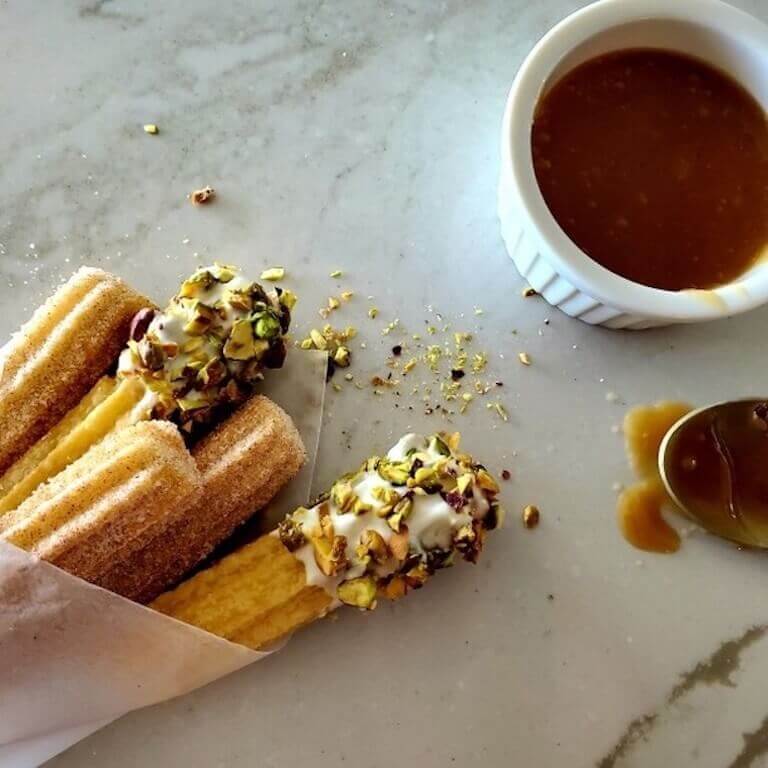
Churros with caramel sauce by Escoffier student Gina K.
Find Clients and Build a Network
Food photographers are usually independent entrepreneurs, so it’s typically up to them to find clients who need their refined skills and specialized services. Potential clients could include independent restaurants or hotels, food manufacturers, magazines and newspapers, grocery stores, food influencers, social media managers, and more.
In order to obtain jobs and keep work coming in, food photographers have to dedicate a portion of their time to building their network and making connections. This can include engaging with culinary professionals, attending food industry events, and leveraging platforms like Instagram to showcase their portfolios. A strong online presence can help photographers reach an audience far outside of their general area.
Food photographers must not only excel in their craft but also be comfortable with self-promotion, pitching their services, and negotiating contracts.
Collaborate with Clients to Understand Their Vision
Once they’ve been hired for a job, food photographers meet with clients to understand their aesthetics and learn how they envision their food. A restaurant may want to emphasize the comfort of hearty dishes, while a high-end bakery might prefer elegant and refined compositions.
Since chefs may plate their dishes in a way that makes sense for the guest but doesn’t result in the best photo, the photographer must find a way to honor the chef’s vision while also creating an appealing image. This could mean adjusting the arrangement, using props, or modifying the plating while remaining true to the chef’s vision.
Great food photography is a matter of detail and patience. A photoshoot may involve rearranging a dish and changing the lighting dozens of times before you capture the perfect shot.
Post-Production: Perfecting the Final Image
Even after capturing the images on camera, the job isn’t done—the photographer must spend time in their “digital darkroom,” editing their photos to make them perfect. By using programs like Adobe Photoshop, Adobe Lightroom, or other editing software, photographers enhance colors, adjust lighting, and correct any imperfections to make the food look as appetizing as possible.
Editing can transform a good photo into a mouth-watering image, creating a polished final product that highlights the textures, colors, and appeal of the dish. This is an important step to help ensure the food shines through marketing materials, social media posts, or print publications.
Delivering and Refining the Final Product
When the editing process is finished, the food photographer can deliver the final product to the client. However, the process isn’t always finished at this point. Clients may want edits and adjustments made so the images better align with their marketing materials.
By maintaining open communication and acting on feedback, food photographers can strive to deliver a final product that meets client expectations and potentially opens the door to future collaborations.
Connect with Other Food Photographers
As with many jobs, it can be helpful to connect with mentors who are further along in their careers. Not only can this give you an understanding of the tasks involved in being a food photographer, but you may also pick up some helpful tips and tricks.
If you don’t know any other food photographers, find someone whose work you admire and ask if you can shadow one of their shoots.
An alternative option to connect with other professionals is to join a local photography club. While other members may concentrate on capturing subjects other than food, you can talk shop about photography and gain access to a group of people willing to critique your photos.
Practice, Practice, Practice!
Once you have an understanding of photography and food, it’s time to hone your food photography skills by breaking out your camera at every opportunity.
While cooking, styling, and capturing an elaborate meal can definitely help you improve your skills, don’t forget about utilizing simple moments as well. Taking photos of your morning oatmeal, simple sandwiches, and takeout meals may also help you refine your skills. By playing with lighting, angles, and props, you may also begin to develop an eye for what works and what doesn’t.
As you practice you might find yourself developing a niche, whether that’s photographing wedding cakes, working with publishers to shoot cookbook photography, or capturing photos for restaurants’ social media campaigns.
Who Is On the Food Photography Team?
Some food photographers are 100% independent, but it’s also common to have a small team working on each photoshoot.
While some food photographers design and style their shoots, others collaborate with food stylists. These professionals arrange the food, plates, accessories, and backdrops to look their best and then hand the actual photography over to the photographer. However, local businesses might expect you to do it all when you come in for a shoot, so understanding some tricks of the food styling trade is essential.
Food Styling Tips & Tricks
Professional food photographers use creative tricks to make dishes look their best on camera:
- Support Structure: Insert dowels to keep stacked or delicate foods upright.
- Elevate Elements: Add a false bottom to soup bowls or plates to highlight key ingredients.
- Grain Placement: Arrange individual grains of rice or herbs with tweezers for precision.
- Steaming Hot: Create fake steam with a dampened cotton ball microwaved for a few seconds.
- Fresh Look: Spray food lightly with glycerin mixed with water to mimic natural condensation.
These clever hacks help ensure every photo is as appetizing and polished as possible!
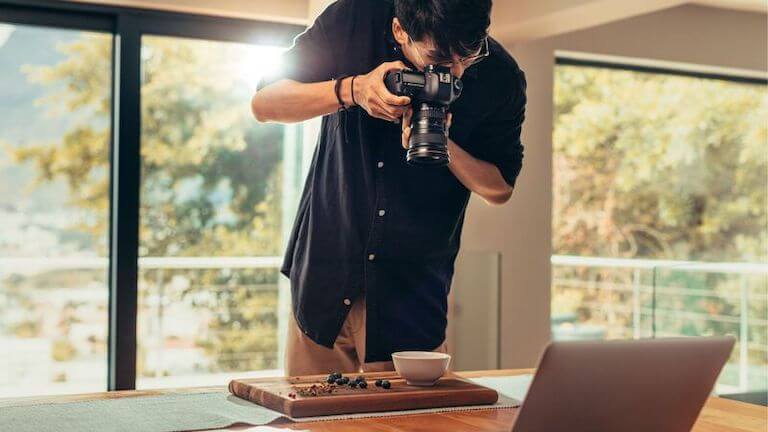
Food photographers use a lot of natural light and work to get the best angle to make food look its best.
Photographers may also bring one or two lighting assistants to help set up equipment and move it as the day progresses. These helpers may also position and hold a reflector to bounce light around and prevent harsh shadows.
If the shoot is for a restaurant, the chef may also be there to help explain their dishes and add their input. Food photographers need to be great communicators so they can both satisfy the chef’s vision and capture a photo that helps the food shine.
What Kind of Gear Does a Food Photographer Need?
If you want to be a professional food photographer, you’ll need a minimum amount of serious photography gear. But don’t let that stop you from getting started. The most important part of most styles of photography — the light, which we’ll discuss shortly — can be had for free if you know what you’re doing.
Perhaps most important: You do not need this year’s model of everything to be a professional food photographer.
Let’s examine the most important areas of gear for a food photographer and discuss what you can use to start out and what you should aim to own if you want regular professional work.
The Best Lighting for Food Photography
The only thing more important to good food photography than lighting is the knowledge to use lighting to its fullest potential. An experienced photographer can do more with one underpowered light than an amateur can with a truck full of expensive lighting equipment. Fortunately, there’s an outlandishly powerful light in the sky for about 10-12 hours each day that you can use to practice.
A Window Into Good Lighting
Window light is among the best light sources for practicing at home, especially north-facing windows where the light remains even throughout the day (in the northern hemisphere, anyway!). You can arrange sample products by window light to see how different arrangements affect the images you take, play with bounce cards to reflect light back onto your subject in different ways, and see how the intensity and color of the light throughout the day affects the final product.
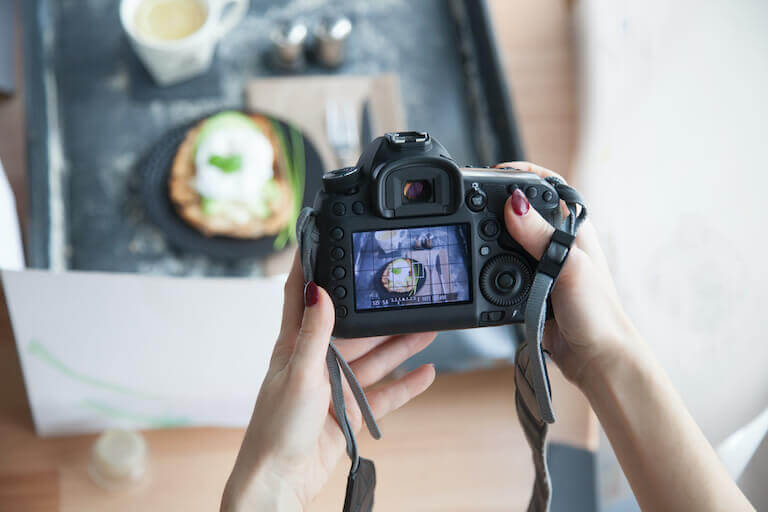
Window light can provide plenty of illumination for good food photography, especially early in your career.
The Best Cameras for Food Photography
There’s no shame in starting out with your phone. For images that will live entirely online, a phone camera can be surprisingly effective. But you surrender a lot of control to the camera app, and the sensor and lenses involved are sub-par for professional jobs.
The camera question is a rabbit hole down which you can spiral for the rest of your natural life. In most cases, people pop out the other end having spent too much money on gear they don’t actually need. That said, your cell phone camera can only take you so far, and you’ll eventually need something with better image quality and manual controls.
The type of camera you’re most likely to acquire is either a digital SLR (DSLR) or a mirrorless camera. These cameras are part of interchangeable lens systems and are often sold as “body only,” meaning that they don’t come with a lens. We’ll talk about lenses in a bit.
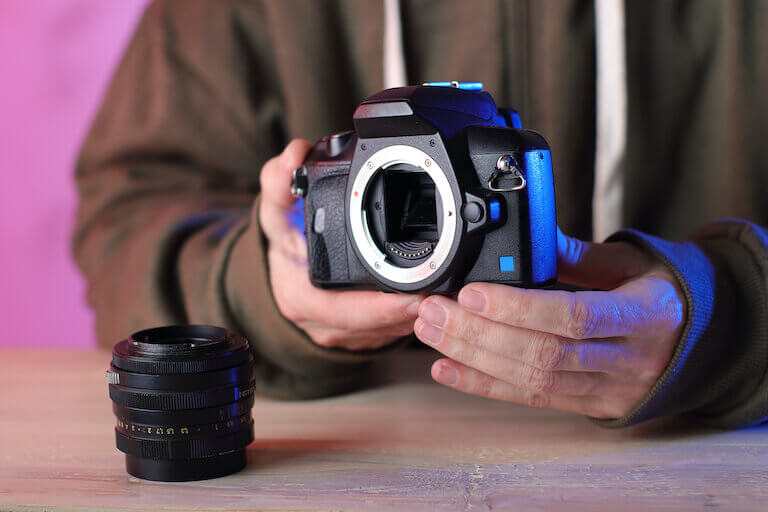
Higher-level cameras have detachable lenses, allowing you to change up the kinds of images they can take.
For food photography, both camera types will serve you equally well, but a mirrorless camera will give you the advantage of a live preview of your shot before you take it displayed on the camera screen. Whichever style you end up with, you’ll be confronted with a dizzying list of specs that can induce a surefire case of analysis paralysis in even the most seasoned camera shoppers.
Here’s a quick rundown of the specs to shoot for in your first “real” camera purchase:
Sensor Size
If you can afford it, spring for a “full-frame” sensor. If you can’t you’ll do fine with one size down from that, an APS-C sensor. Anything smaller will begin to sacrifice image quality and lens selection too severely.
Megapixels
Megapixels only matter in this field and with these cameras when you’re talking about print size. In food photography, most images are optimized for digital platforms like websites, social media, or menus. These platforms typically don’t require more than 2–5 megapixels after resizing for web standards. Therefore, a camera with 24 megapixels provides plenty of resolution while allowing room for cropping or detailed editing. If you end up with a client that needs to print a billboard, they’ll use upscaling software and rely on viewing distance to make up for any shortcomings in print resolution.
Bit Depth
An overlooked stat among cameras is bit depth, which determines how much flexibility you’ll have when adjusting colors and exposure in post before artifacts start to creep into the image. You want to aim for a 14-bit depth where you can find it. Most late model cameras should offer this.
Screen Articulation
Many modern cameras have back screens that pop out and twist around, allowing you to view them from multiple angles. These are essential for shots with difficult camera placement when you aren’t using an external monitor or tethering your camera to a computer.
Image Stabilization
If you’re using a tripod or strobes, image stabilization is less necessary, but if you’re starting out with minimal gear and you need to slow your shutter speed down to expose properly, you might end up getting some motion blur from unsteady hands. Image stabilization can correct for this, and 5-axis stabilization is a good standard.
Camera Specs You Can Ignore
For food photography, there are several specs that some camera makers will swear can make or break your career, even though you could probably ignore them:
- Burst rate: Except on rare occasions, you’ll only take one picture at a time.
- Autofocus features: Food doesn’t move too much, so fancy AF features aren’t necessary.
- Viewfinder resolution: You’ll rarely use the viewfinder when composing a food photograph.
- Videography features: If you’re getting a recent model with a full-frame or APS-C sized sensor, it’s going to have good enough video features for anything you’ll need to do.
- Weather sealing: Most food photography will take place in controlled environments, not in the rain or snow.
The Best Lenses for Food Photography
You’re liable to run into situations that call for different lens types, but there’s one lens that will prove the most versatile for a burgeoning food photographer, and that’s a macro lens around 100mm in focal length. That immediately raises two questions: why a macro lens, and why 100mm? Let’s answer them!
Why a Macro Lens?
Macro lenses can get extraordinarily close to subjects and still focus on them, producing beautifully magnified images. Ever seen a picture of an insect that was a little too close for comfort? That was undoubtedly shot on a macro lens. With a macro, if your client needs you to get in close, you can do it. Macro lenses also function very well when used as normal lenses from other distances, essentially giving you two tools in one.
Why a 100mm Focal Length?
The 100mm recommendation isn’t terribly strict, but a range from around 85mm to 105mm offers the most realistic reproduction of a subject as the human eye sees it. It may even be a little more flattering than the human eye. That can help the food you shoot look as good as possible, and if you want to branch out into other photographic ventures, like portraits, you’ll have a flattering lens for that, as well.
Miscellaneous but Critical Gear for Food Photography
You can show up to a shoot at a restaurant with a great camera and lenses, outstanding lights, and the know-how to make it all come together to create beautiful images. But there are a few miscellaneous items that you may want around, the absence of which could bring an otherwise successful shoot crashing down.
- Gaffer’s tape (or gaff tape): As strong as duct tape but far less likely to damage the surfaces it touches. Also typically black, so it won’t cause unwanted reflections.
- Color card: Depending on the lighting setup, having a color card for a reference photo can help you get an accurate white balance when editing.
- Clips and clamps: Various kinds, including clothespins
- Sandbags (with sand in them): Help stabilize light stands to prevent accidents
- Reflectors and bounce cards: Helps photographers control lighting and shadows
- Food-safe brushes: Used for decorating, finishing touches, and also for brushing away crumbs
- Spray bottles: Used to spray mist on food to make it look fresh, cold, juicy, and the like
- Backgrounds and props: Can include things like cutlery, cutting boards, cake stands, and much more
Capture a New Career in Food Photography
If you want to become a food photographer, one of the first steps is developing a thorough understanding of food! Whether you’re an experienced home cook or are new to the culinary world, culinary school can help introduce you to new dishes, techniques, and terminology.
Learn more about Escoffier’s on-campus or online culinary programs and take the first step toward a career as a food photographer.
WAS THIS ARTICLE HELPFUL? TRY THESE NEXT:
- How to Become a Chef: The Complete Guide
- Career Options for Culinary School Graduates
- How to Become a Food Influencer
This article was originally published on November 15, 2015, and has since been updated.
